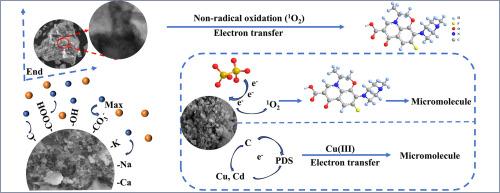当前位置:
X-MOL 学术
›
Water Res.
›
论文详情
Our official English website, www.x-mol.net, welcomes your
feedback! (Note: you will need to create a separate account there.)
In situ generation of Cu(III) synergized with crystalline amorphous strong interfacial interaction for autocatalytic degradation of LEV
Water Research ( IF 11.4 ) Pub Date : 2025-05-29 , DOI: 10.1016/j.watres.2025.123873
Chun Zhang, Qin Chen, Yuxuan Li, Zhiyong Cai, Zhiguo Wang, Wei Huang, Peng Yu
Water Research ( IF 11.4 ) Pub Date : 2025-05-29 , DOI: 10.1016/j.watres.2025.123873
Chun Zhang, Qin Chen, Yuxuan Li, Zhiyong Cai, Zhiguo Wang, Wei Huang, Peng Yu

|
The practical potential of metal catalysts in the advanced oxidation degradation of antibiotics has been seriously limited due to the secondary pollution caused by their application. To tackle this challenge, this study proposes an innovative approach that utilizes attapulgite/biochar composites for adsorbing heavy metals in wastewater and forming biscuit-type composites with crystalline/amorphous structures to effectively degrade antibiotics. The results show that a bimetallic amorphous layer forms on the surface of materials after Cu and Cd adsorption. This distinctive bimetallic amorphous/crystalline structure can generate highly active intermediates (e.g., Cu(III)) through an electron transfer mechanism, which is essential for the subsequent removal of levofloxacin (LEV). By investigating the formation mechanism of the amorphous/crystalline structure, it is revealed that this structure exhibits superior catalytic performance compared to the crystal structure. Moreover, this research offers an in-depth analysis of the interactions among multiple contaminants, elucidating the pivotal roles played by Cu(III) and Cd in this process. This discovery offers a novel perspective on the practical treatment of wastewater, enhancing not only the efficiency of the process but also the reduction of potential secondary contamination. It also provides a promising avenue for the advancement of environmentally conscious wastewater treatment technology.
中文翻译:

原位生成 Cu(III) 与结晶非晶强界面相互作用协同作用,用于 LEV 的自催化降解
由于应用金属催化剂会造成二次污染,金属催化剂在抗生素高级氧化降解中的实际潜力受到严重限制。为了应对这一挑战,本研究提出了一种创新方法,利用凹凸棒石/生物炭复合材料吸附废水中的重金属,并形成具有结晶/无定形结构的饼干型复合材料,以有效降解抗生素。结果表明,Cu 和 Cd 吸附后,材料表面形成双金属非晶层。这种独特的双金属无定形/晶体结构可以通过电子转移机制生成高活性中间体(例如 Cu(III)),这对于随后去除左氧氟沙星 (LEV) 至关重要。通过研究非晶/晶体结构的形成机制,发现与晶体结构相比,这种结构表现出优异的催化性能。此外,本研究对多种污染物之间的相互作用进行了深入分析,阐明了 Cu(III) 和 Cd 在此过程中发挥的关键作用。这一发现为废水的实际处理提供了新的视角,不仅提高了工艺效率,还减少了潜在的二次污染。它还为推进具有环保意识的废水处理技术提供了一条有前途的途径。
更新日期:2025-05-29
中文翻译:

原位生成 Cu(III) 与结晶非晶强界面相互作用协同作用,用于 LEV 的自催化降解
由于应用金属催化剂会造成二次污染,金属催化剂在抗生素高级氧化降解中的实际潜力受到严重限制。为了应对这一挑战,本研究提出了一种创新方法,利用凹凸棒石/生物炭复合材料吸附废水中的重金属,并形成具有结晶/无定形结构的饼干型复合材料,以有效降解抗生素。结果表明,Cu 和 Cd 吸附后,材料表面形成双金属非晶层。这种独特的双金属无定形/晶体结构可以通过电子转移机制生成高活性中间体(例如 Cu(III)),这对于随后去除左氧氟沙星 (LEV) 至关重要。通过研究非晶/晶体结构的形成机制,发现与晶体结构相比,这种结构表现出优异的催化性能。此外,本研究对多种污染物之间的相互作用进行了深入分析,阐明了 Cu(III) 和 Cd 在此过程中发挥的关键作用。这一发现为废水的实际处理提供了新的视角,不仅提高了工艺效率,还减少了潜在的二次污染。它还为推进具有环保意识的废水处理技术提供了一条有前途的途径。


















































 京公网安备 11010802027423号
京公网安备 11010802027423号